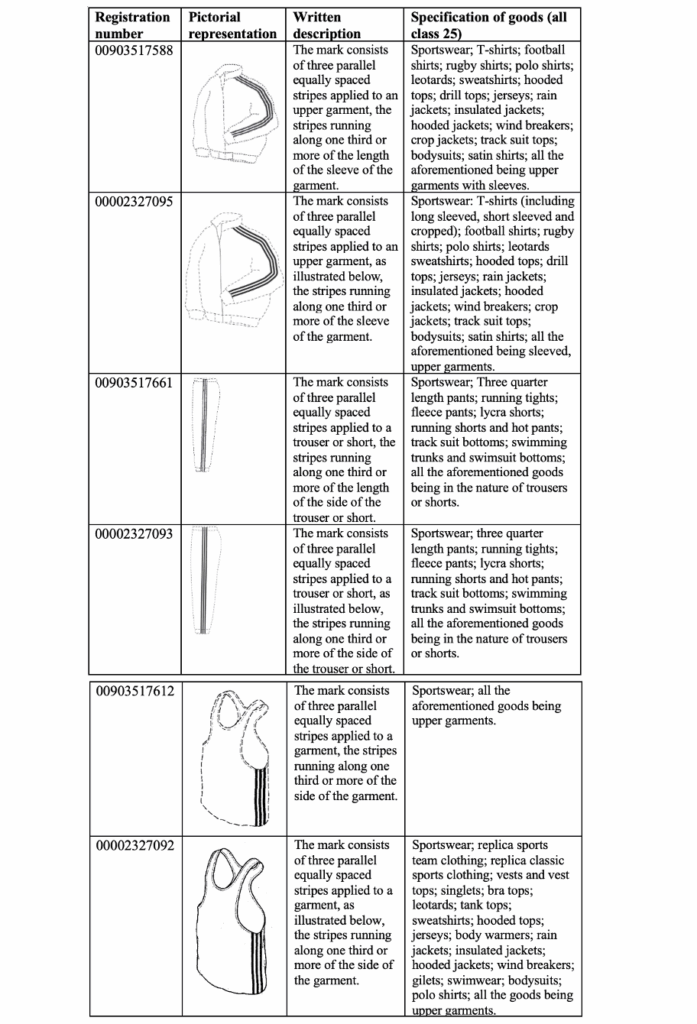Adidas’ ongoing fight over stripes has hit a snag. The U.K. Court of Appeal has dismissed the German sportswear giant’s attempt to salvage six of its position trademarks, marking the latest setback in its long-running effort to assert dominance over its famous “three stripes” motif. The ruling leaves intact the High Court’s earlier decision that invalidated eight U.K. position mark registrations owned by adidas (six of which adidas appealed), a move that narrows the brand’s enforcement arsenal against rivals like Thom Browne.
The Background in Brief: The dispute stems from proceedings initiated by Thom Browne and its UK subsidiary, which sought declarations of invalidity or revocation for 16 adidas trademark registrations covering clothing, footwear, and accessories. In November 2024 the High Court found that eight of those marks, all depicting variations of the three-stripe design, were invalid for lack of registrability under Section 1(1) of the Trade Marks Act 1994, prompting an appeal from adidas.
A Narrow but Notable Appeal
Adidas’ appeal focused narrowly on whether the High Court erred in invalidating its six position marks, each depicting variations of its iconic three-stripe motif placed along the sides, sleeves, or legs of garments. The marks were described as “three parallel, equally spaced stripes applied to a garment,” running along one-third or more of the length of the sleeve, leg, or side. Each registration included both a written description and an illustrative drawing, but the relationship between the two became the core issue on appeal.
Delivering the leading judgment, Lord Justice Arnold emphasized that the interplay between text and image was “central to the issues on this appeal,” as adidas had characterized its drawings as “examples” rather than strict limitations, thereby, leaving open a wide range of possible stripe placements and proportions. The Court of Appeal agreed with the High Court that such flexibility undermined the clarity and precision required by law.

Citing EU case law that continues to inform UK practice post-Brexit, the court reaffirmed three essential conditions for registrability: (1) the mark must be a sign, (2) it must be capable of graphical representation, and (3) it must be capable of distinguishing one undertaking’s goods from another’s. This case turned on the first two. The judges found that the written descriptions allowed for an impermissible multiplicity of signs, making it impossible to identify a single, objectively ascertainable mark. As Arnold put it, “The subject matter of the registration was not a single sign, nor was it represented clearly and precisely.”
The problematic phrase “one third or more” exemplified the issue. While seemingly specific, it introduced broad variability in how long the stripes could extend – a level of flexibility incompatible with the principle that a trademark must convey exactly what is protected. In substance, the court concluded that the forms embraced by the description were not readily ascertainable from the words and the illustration when read together.
The Dyson Argument
Adidas attempted to challenge this reasoning by invoking the CJEU’s decision in Dyson, in which the vacuum manufacturer’s attempt to register the concept of a transparent dust container was rejected. The brand argued that the High Court misapplied the decision in Dyson, insisting that the mere possibility of “unrepresented variants” should not automatically invalidate a mark.
The Court of Appeal disagreed, holding that High Court Justice Joanna Smith had not treated the existence of unrepresented forms as determinative, but rather as one of several indicators that the registrations lacked precision. The question, Arnold explained, “is whether the extent of the variations embraced by the written description is impermissible.” On that point, the court was clear: it was.
Adidas also argued that the High Court went too far in suggesting that the stripes might appear on the underside of a sleeve, but the appellate judges dismissed that contention as immaterial. The underlying problem, they said, was not where the stripes began or ended but the fact that the written description itself “encompassed variability in the starting points, ending points, and length of the stripes”. Even if the High Court had over-interpreted in one instance, “the reasoning would be unaffected.”
The Position-Mark Problem
Justice Falk underscored that position marks – those defined by their placement on a product – demand particular precision because “their distinctive character derives at least in part from their positioning.” Where a mark’s position can vary substantially, the scope of protection becomes uncertain.
The Court of Appeal upheld the High Court’s conclusion that the six marks were invalid, holding that they failed to meet the first two conditions for registrability under the Trade Marks Act 1994. Other adidas registrations were not before the Court.
For example, one tracksuit-top registration required the stripes to run “one third or more” of a sleeve’s length, yet the illustration showed full-length sleeve stripes from collar to cuff – underscoring the gap between a broad written description and a single, non-limiting image. Such ambiguity, the court found, made it impossible for authorities or competitors to determine the scope of protection – and risked granting Adidas an undue competitive advantage.
A Broader Message for Brand Owners
The Court of Appeal’s decision cements a growing trend in European and U.K. jurisprudence: position trademarks remain registrable, but only when depicted and described with exacting precision. Overly flexible wording, or reliance on reputation to fill in the gaps, will not suffice. For adidas, the decision represents another judicial rejection in its effort to maintain control over the three stripes.
For other brands, it serves as a cautionary tale: even the most recognizable visual motifs must be defined, not implied. In a world where minimalism reigns and designers increasingly rely on subtle recurring details, clarity has become not just a legal standard but a strategic necessity.














